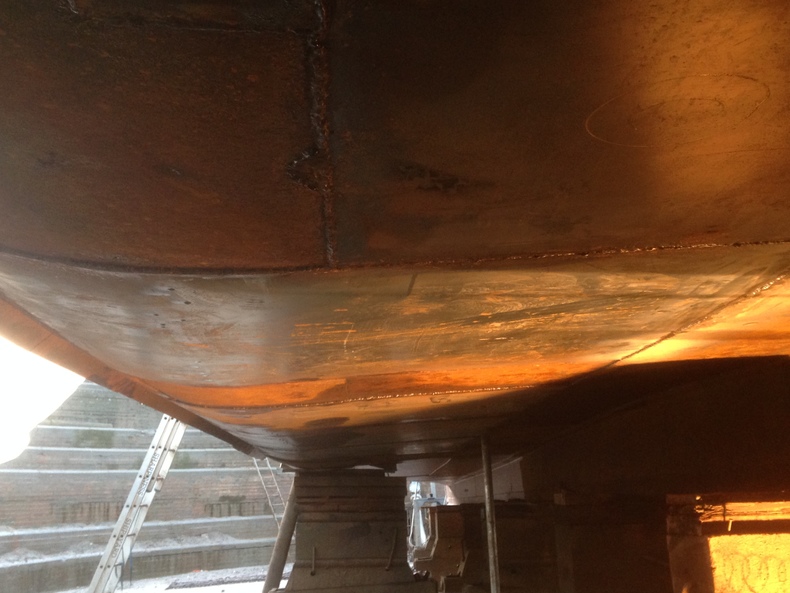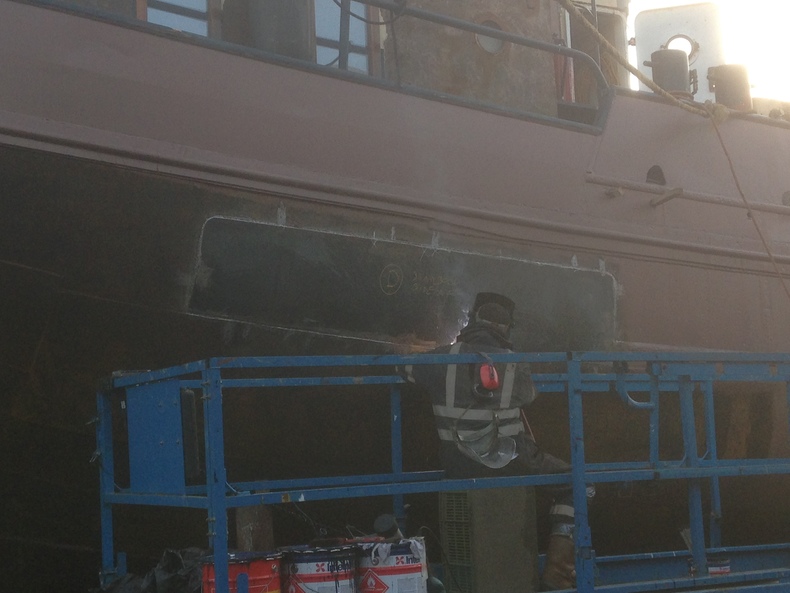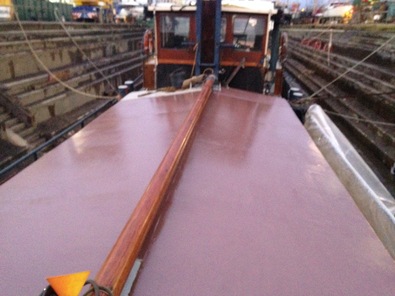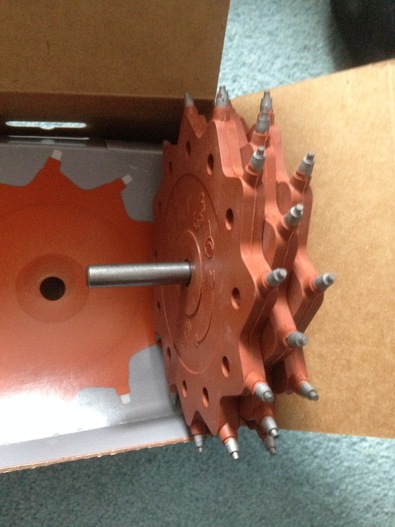It would appear that the bad news may have come to an end (at least temporarily). The welders have worked the entire weekend as the commercial vessel had to sail this morning so they have been up against it to get all the plating below the waterline finished. As I tickle the keyboard and grasp words of wisdom from the ether and convert them to digital form, Zee has been refloated, but she will have to be set back down in a while in order to allow a second commercial vessel into dry dock for repair, for the above waterline work to be completed and for the painters to come back and finish the hull. The commercial vessel in after us needs rudder repairs so we might not be out of dry dock until towards the end of January. Currently there are about 4 areas which are leaking, a couple of rivets, a rivet band and an area of steel delamination which could be capillary action. They have stopped leaking and the rivets seems to be healing, but they will all be investigated and repaired if necessary. Fore and aft are bone dry which is good.
Staying in dry dock may be viewed by some as bad news but actually it will enable me to continue working on the 'dirty and noisy' jobs. I hope to be able to weld over the portholes and to fill the bolt holes with weld and make the cargo hold 'weather tight'.
The full extent of the plating work can be seen in the following images:






What has made a big difference is that the painters managed to get in and apply a single coat of Jotun Jotamastic 87 as a holding primer to try and maintain the majority of the hard work carried out by the blasters. They had to hand roller it on so it is probably only about 50 microns thick, but this will be enough to grab the substrate and be a good 'primer' for a second, thicker coat of Jotamastic. They were not allowed to spray due to the danger of flash or explosion as the paint's volatile organic compounds evaporated.

It is pretty easy to apply but some tips from the professionals if you are using 2 pack paints:
1) It is preferable not to paint over a rust converter/acidic base. It can affect the paint's hold
2) Do not wire brush the metal - it needs to be rough for the paint to grip
3) Even if it looks a bit rusty, wipe your hand over the steel, if it comes off without a considerable layer of dust and crud on it, it is fine to paint over. These types of paint are resilient to surface roughness and actually prefer a little bit of surface rust (not flake or heavy corrosion) to help it grip.
4) Temperature makes a massive difference. If it's cold you will have am much longer working time with the paint but additionally takes longer to cure which adds to the painting time. Not a problem if like me you are doing section by section up top, but a real problem if you are a professional sprayer hoping to get in and out quick...
5) A roller will put a layer on of about 50 microns. If you buy your paint from a major paint producer, they should be able to advise of a suitable paint thickness for the purpose.
6) You can apply 1 pack over 2 pack, but not the other way around. 2 pack on 2 pack is fine.

New Tool - No I am not describing Donald Trump. He is an old tool. And my new tool is actually fit for purpose and unlikely to start WW3...
This is a TERCOO Rotary Blaster. Just for full disclosure, I paid full price and am not paid for promoting their tools... They aren't cheap. The triple disc displayed here is about £66 (not inc P&P). They do single, double, triple discs which are suitable for hand held drills. For the more serious professional, they do a 6 and 8 disc version but these require a specialist tool and cost upwards of £500 (notable a similar price to the rotary scabbler I used, and funnily enough, supplied by the same people - Refina). The discs seem to be made out of a stiff-ish rubber with tungsten tips. They do not rotate freely but there is a certain amount of lateral movement.
The triple is touted to be able to strip 30 square metres before it needs to be replaced and provides a surface finish equivalent to shotblasting but without the ball ache of all the equipment. Getting right into corners and hard to reach areas is a problem but for large, flat areas this seems like a good option. From watching videos on Youtube it would appear a very light touch is the best way to use this and maximise its life. I may well do a video review as having recently done shot blasting and scabbling it would be interesting to compare and contrast (and that's not a sentence I ever thought I would hear myself saying...).
Zee will probably be set down again just after Christmas when some of the patching above the waterline will continue. I hope to be able to get on her and start welding over the portholes in order to save some money. I have been speaking to the welders and gaining some tips and tricks of the trade and they seem only too happy to chat through with me. Other jobs will include further stripping and surface prep and then applying a suitable coat of the Jotamastic and then the off white base coat, although I suspect I will wait until we are back in the marina and don't have a bunch of hairy arsed shipyard workers trampling all over the new paintwork before I put the cream and topcoat on.
Interestingly (or not, although if you have read this far I can only assume you are slightly 'barge nerdy' just like me) while I was applying anti rust treatment in the foc'sle the other day I noticed some different frames and some weld marks. You can see them from the outside now she has been stripped...
 There is a weld line which corresponds with where the new frames have been welded in place. They aren't rivetted to the hull so it must have been a more recent repair and seems to indicate she suffered a pretty severe impact which pierced the hull and necessitated new frames and a fairly major steel insert. Well done to Selles and Van Dijk again for missing that one... You muppets...
There is a weld line which corresponds with where the new frames have been welded in place. They aren't rivetted to the hull so it must have been a more recent repair and seems to indicate she suffered a pretty severe impact which pierced the hull and necessitated new frames and a fairly major steel insert. Well done to Selles and Van Dijk again for missing that one... You muppets...
With Zeelandia residing on the water and only accessible by boat, I suspect work will have finished until I get back from various family Christmas celebrations. In some respects that is a good thing -
having moved about 50 bags of sand ballast by hand, my tennis elbow/tendonitis is back with a vengeance so it could probably do with a break. With that, I would like to wish all my shipmates a very happy, prosperous and healthy Christmas and New Year.
Brownian motion-type musings on barge renovation, life and other bits of flotsam.




